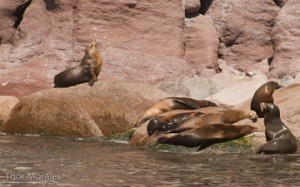Frolicking dolphins, dive-bombing boobies, and sunset over Tiburon Island
It’s hard to believe that our trip is coming to an end. We have seen so much, been exposed to many new experiences, explored complex science and policy questions, and grown together as a group. For our last day in the Gulf, we set our sights on San Esteban Island which lies somewhere between San Pedro Martir (see Day 3) and Tiburon islands (see Day 6) in location, size, and level of protection.
As has become our custom, Cosme is at the helm and Xavier is standing in the bow, scanning the horizon for wildlife. Their keen and experienced eyes see things that are invisible to me: splashing water in the distance tells them there are tunas feeding, smooth patches of water and squawking birds indicate schools of sardines, and nesting ospreys are spotted from afar. We grab binoculars and search in the direction of their outstretched fingers.
 But as we round the southern end of Tiburon Island no instructions are needed to spot the dozens of dolphins racing, jumping, and frolicking all around us. They ride the bow wave, skim through our wake, and leap 12 feet into the air, landing with a splash to our squeals of delight.
But as we round the southern end of Tiburon Island no instructions are needed to spot the dozens of dolphins racing, jumping, and frolicking all around us. They ride the bow wave, skim through our wake, and leap 12 feet into the air, landing with a splash to our squeals of delight.
The fish and fishermen of the Gulf of California have been a major focus of our trip. We stop alongside a fishing “panga” (the Gulf’s ubiquitous, small, fiberglass motorboat) to chat with three Kineños (men from the nearby town of Kino) who are setting traps for spotted bass … and whatever else they pull up. Later, our boatman Cosme tells us a hilarious shaggy-dog story about being chased by the military in his former days as a fisherman. Near San Esteban Island, Cosme and his companions spotted a government boat in the distance and made a run for it, fearing they would be caught with their illegal catch. The officials gave chase, firing warning shots into the water, to the dismay of the defenseless fishermen. The story ends happily when it turns out the officers were looking for drug traffickers and had no interest in a boat full of illegal sea cucumber, flounder, and lobster.
 Finally we arrive at San Esteban itself where hundreds of sea lions lounge on the beach, lazily slipping in and out of the water, confirming this island’s status as the largest sea lion rookery in the Gulf of California. The animals are grouped into bunches composed of a single dominant bull with perhaps a dozen females and juveniles, while younger males lurk on the fringes awaiting their chance one day to take over. We are warned away with eerie, low, bellowing calls.
Finally we arrive at San Esteban itself where hundreds of sea lions lounge on the beach, lazily slipping in and out of the water, confirming this island’s status as the largest sea lion rookery in the Gulf of California. The animals are grouped into bunches composed of a single dominant bull with perhaps a dozen females and juveniles, while younger males lurk on the fringes awaiting their chance one day to take over. We are warned away with eerie, low, bellowing calls.
Next, we circumnavigate the island, spotting birds of all types: pelicans, boobies (brown and blue footed!), cormorants, yellow-footed gulls, osprey, murellets, blue herons, red-billed tropic birds, grebes, and much more. Finally we drop anchor, squeeze into our wetsuits, and dive into the chilly waters of the Gulf to swim with parrotfish, rays, angelfish, and octopus, and to stare into the eyes of the sea lions gliding noiselessly all around us. Truly an experience beyond words.
 We climb back aboard (I am always the last to be dragged unwillingly out of the water), rest a few moments in the sun, and glumly point our prow back toward shore. But the generous Gulf ecosystem has one more gift in store for us. Our homeward course takes us past massive flocks of birds (those boobies again) dive-bombing the ocean. From a height of 60 feet, they tuck back their wings, streamline their bodies, and head straight down, spearing the surface of the water. When their bellies are full to bursting with sardines and anchovies, they head back to their nests on San Pedro Martir Island (see the blog entry for Day 3).
We climb back aboard (I am always the last to be dragged unwillingly out of the water), rest a few moments in the sun, and glumly point our prow back toward shore. But the generous Gulf ecosystem has one more gift in store for us. Our homeward course takes us past massive flocks of birds (those boobies again) dive-bombing the ocean. From a height of 60 feet, they tuck back their wings, streamline their bodies, and head straight down, spearing the surface of the water. When their bellies are full to bursting with sardines and anchovies, they head back to their nests on San Pedro Martir Island (see the blog entry for Day 3).
Thus ends our memorable—in fact, life-changing—trip to the Gulf of California and its complex social and natural ecosystem. We disembark at the Kino landing ramp, watching the glorious sunset over Tiburon Island.
